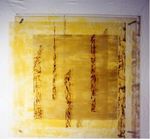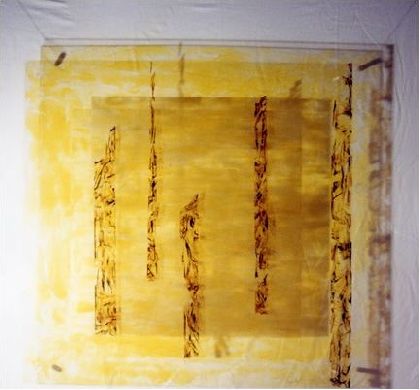The classification provides four or more codes placed on four axis (A - formalism, B - matériality, C - involvement body/mind, D - communication). These codes are positionning the artist in the art history.
A axis : FORMALISM
When looking at the work, what type of formalisation first strikes the eye? Is it more abstract or more figurative, etc ? (on a scale from more "immaterial" to more "realist").A210 : Abstracts with signs
The work as a whole remains abstract but includes (or consists entirely of): signs forming writing: writing without meaning
the sign as an abstract shape placed in the composition of the pictorial space (R.Motherwell, Giuseppe Capogrossi, Christian Dotremont, Cy Twombly, ...).
B axis : MATERIALITY
How does the materiality of what is shown come across?
(on a scale from more "immaterial" to more "real").B100 : Immateriality complete immateriality
or various illusions, especially with sound (Philippe Parreno's "Walkman"), light, holograms, smells (James Turrell, ...), Fractal Art (Luc Briard).
C axis : INVOLVEMENT BODY/ MIND
With what body:mind ratio does the artist enter into his work?
Classify from the most "intellectual" (e.g."Concept Art"...) to the most "physical" (e.g. "Body Art", ...).C180 : tending towards the corporeal / the senses via expression with a frank sensuality, or even openly sexual
either literal (Courbet's "Origin of the world", Lucian Freud, John Kacere, P. Klossowki, David Salle, Gilbert and George, ...),
- symbolic (Paul Armand Gette, Andreas Serrano, ...),
- humorous (Gilles Barbier "cerveau", Boyd Webb "the globe" , ...),
- or "realist" (certain "Body-artists" such as Otto Muehl, Paul Mc Carthy's "installations" , Zoran Naskovski's videos, ...), ...
D axis : COMMUNICATION
Does the artist have the deliberate intention to convey a message of any sort through his work?
(classified from the most "mystical" to the most "worldly").D130 : via what is meaningful
based on the idea that work on what symbolizes forms an intentional message in itself (for example: Daniel Dezeuze's "Stretchers", etc., etc., ...). by variations in execution
seriality, multiplication (Claude Viallat, Niele Toroni, "figurines" by Antony Gormley, ...), accumulation or compression (J. Chamberlain, Arman, César, ...), subtleties and variability of the material (Rober Ryman's "Whites"; dissolutions of "matter / life" by Roman Opalka or by On Kawara; Gilberto Zorio, ...).
DALTROFF Chris
www.chris-daltroff.com |




